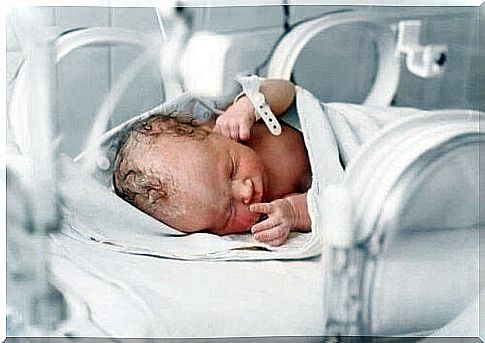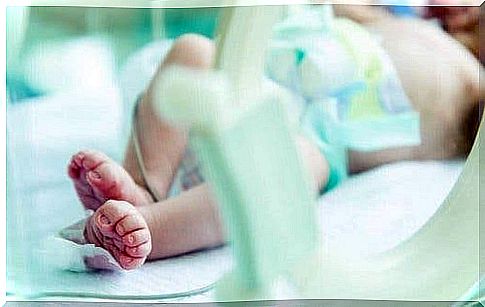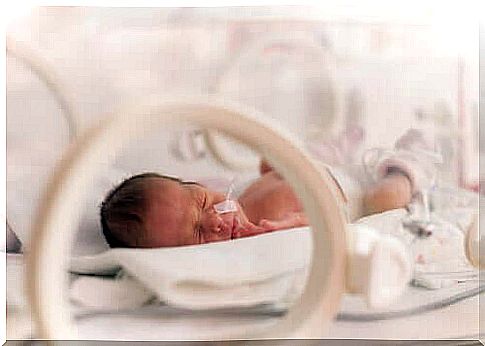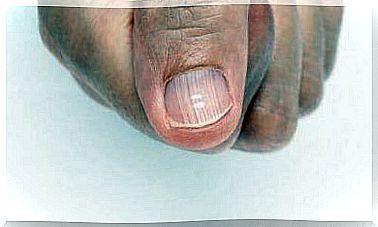Gastroschisis In Newborns: A Birth Defect

Gastroschisis in newborns is one of the most common birth defects, but the majority of the population has never heard of it. This deformity or birth defect occurs when the muscles in the baby’s abdominal wall do not form properly during early pregnancy.
If a newborn has gastroschisis, it means there is a hole in the abdominal wall through which the baby’s intestines and other organs come out. This opening is usually located on the right side of the belly button.
Because the intestines are exposed to the amniotic fluid, they can become irritated. For this reason, they can shorten, swell or twist.
Immediately after birth, the baby needs surgery to reposition its organs in the abdominal cavity and to repair the abdominal wall. Despite surgery, babies with gastroschisis may have problems with feeding, digestion, and nutrient absorption.
Causes and risk factors of gastroschisis in neonates
Some cases of gastroschisis in newborns are due to genetic mutations. On the other hand, this condition can also develop due to the combination of genetic factors and aspects of the mother during pregnancy. The following are factors that may increase your risk of having a baby with gastroschisis:
- Becoming a mother at a young age: Teenage mothers are more likely to have a baby with gastroschisis than older mothers.
- Tobacco and alcohol use: Women who smoke and use alcohol are at a higher risk of having babies with gastroschisis, among other very serious diseases and conditions.
Diagnosis and Treatment

The diagnosis can be made before birth or as soon as the baby is born. Medical specialists can perform malformation detection tests during pregnancy.
As a result, thanks to special types of analysis, gastroschisis in babies can be detected while the woman is still pregnant. In addition, this condition is visible with the help of an ultrasound.
As for treatment, gastroschisis in newborns is a life-threatening condition. The baby should therefore be treated as soon as possible after birth so that the organs can develop and be protected in the abdomen.
If the defect is not so bad, surgeons may be able to treat the condition with a single intervention. However, if it is a severe birth defect, meaning multiple organs are outside the abdomen, multiple surgical procedures may be necessary. After surgery, the baby will have to go to the neonatal intensive care unit.
Risks of the operation
The risks of anesthesia and general surgery include:
- Allergic reactions to drugs
- Breathing problems
- Infection and bleeding
In addition, there may be the following risks associated with the recovery of gastroschisis:
- Breathing problems: These can occur if the baby’s tummy space is smaller than normal. The newborn may need a breathing tube and ventilator for a few days or weeks after surgery.
- Inflammation of the tissue that lines the abdominal wall.
- organ injury
- Temporary paralysis of the small intestine
- Hernia in the abdominal wall
Additional treatments for gastroschisis in neonates

In addition to surgery, babies with gastroschisis often need other treatments. Think of:
- Nutrition through a nasogastric tube that is placed in the nose to empty the stomach and keep it that way
- Intravenous fluids and nutrients
- Oxygen
- Antibiotics to Prevent Infections
- Painkillers
Feeding begins through a nasogastric tube once the baby’s bowel function resumes after surgery. However, the transition to oral nutrition will be very slow. Medical discharge from the hospital usually takes place within 15 to 25 days of admission.
Prevention gastroschisis
To prevent gastroschisis in newborns, adequate prenatal care, as well as healthy habits, is very important. In addition, it is important to schedule all necessary consultations with your doctor to avoid complications. Once your doctor has made the diagnosis, you will need specialized attention and close follow-up.
In these cases, the ultrasound plays an important role. You should have an ultrasound every week from your thirtieth week of pregnancy.
In general, newborns with gastroschisis have a low birth weight and between 10 and 20% have intestinal malformations. However, the baby’s prognosis largely depends on the degree of intestinal distress.
The survival rates of babies suffering from this condition have improved significantly in recent years. This progress is largely due to early detection and prenatal monitoring protocols, as well as appropriate intensive care.









